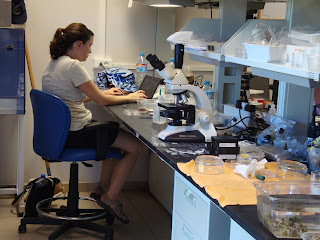Here is Sarah on our Bellows trip to the keys, making sure that we don't kill ourselves by toppling over the stern in an invertebrate-induced frenzy. Sarah and I were co-chiefs on that research cruise, although Sarah was a little more chief and I was a little more co. Goodness knows what we would have done without her!
 Sarah was invaluable in the field, willing to dive in and get wet (as she's preparing to do in this photo),
Sarah was invaluable in the field, willing to dive in and get wet (as she's preparing to do in this photo), or buckle down to do some lab work. Here she is doing some data entry in Moorea. Although she chose a different chair than I did in the Biocode lab, the focused gaze developed after hours in front of the computer deciphering field notes is one with which I am all too familiar.
or buckle down to do some lab work. Here she is doing some data entry in Moorea. Although she chose a different chair than I did in the Biocode lab, the focused gaze developed after hours in front of the computer deciphering field notes is one with which I am all too familiar. In addition, Sarah was brave in the face of danger. In this photo she is being attacked by a clam, but seems surprisingly calm, even cheerful. Nerves of steel!
In addition, Sarah was brave in the face of danger. In this photo she is being attacked by a clam, but seems surprisingly calm, even cheerful. Nerves of steel! We also called upon Sarah back at HQ. "Hey Sarah," we'd say, "remember all those specimens you collected and/or processed in the field? They're not going to rehouse themselves."
We also called upon Sarah back at HQ. "Hey Sarah," we'd say, "remember all those specimens you collected and/or processed in the field? They're not going to rehouse themselves." In between trips to the field, rehousing, cataloging, photo matching, Geneiousing, DNA-extracting, subsampling, photographing, reorganizing, ethanol-procuring, supply-ordering, loan-processing and so forth, Sarah managed to find time for an sea urchin project in which she used genetic data and morphology to elucidate the evolutionary changes in spine shape and pattern in a group of sea urchins. In this photo she's scrutinizing pedicellariae under the microscope.
In between trips to the field, rehousing, cataloging, photo matching, Geneiousing, DNA-extracting, subsampling, photographing, reorganizing, ethanol-procuring, supply-ordering, loan-processing and so forth, Sarah managed to find time for an sea urchin project in which she used genetic data and morphology to elucidate the evolutionary changes in spine shape and pattern in a group of sea urchins. In this photo she's scrutinizing pedicellariae under the microscope. Sarah was great as a scientist, it was an added bonus that she was also great as a chef. Our potluck lunches and parties were much augmented due to her skills in the kitchen, but our gain also turned out to be our loss. We miss Sarah, but we hope she'll come visit and bring all her new culinary school knowledge with her. Maybe we'll have a potluck....
Sarah was great as a scientist, it was an added bonus that she was also great as a chef. Our potluck lunches and parties were much augmented due to her skills in the kitchen, but our gain also turned out to be our loss. We miss Sarah, but we hope she'll come visit and bring all her new culinary school knowledge with her. Maybe we'll have a potluck....:) Mandy















































